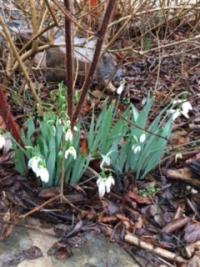 It must be the season, or the year. This snowless winter I was part of three retreats, one per month, about finding the grace in darkness even while leaning toward the light, about the essential rhythms of descent and renewal which keep our lives and our planet from ending, about the fertile dark as soil for the seeds of hope. There seems to be a need in these shadowy times to seek the lantern of soul and to hold onto one another while we quest, hands clasped in sacred circles. During these retreats, we danced in this way in fields in the late afternoon as the sun turned rose and coral and the moon appeared delicately in the lambent sky.
It must be the season, or the year. This snowless winter I was part of three retreats, one per month, about finding the grace in darkness even while leaning toward the light, about the essential rhythms of descent and renewal which keep our lives and our planet from ending, about the fertile dark as soil for the seeds of hope. There seems to be a need in these shadowy times to seek the lantern of soul and to hold onto one another while we quest, hands clasped in sacred circles. During these retreats, we danced in this way in fields in the late afternoon as the sun turned rose and coral and the moon appeared delicately in the lambent sky.
This year our community supper gatherings, which we hold weekly on Thursdays, fell precisely on the solstice (December 21) and on the cross-quarter day (February 1) midway between solstice and equinox. This serendipity could not go uncelebrated. The solstice was easy: we built a bonfire after supper, told stories, sang songs, and made merry.
The cross-quarter day was less familiar. To the ancient Celtic peoples it was a day of hope, a harbinger of spring. They called it Imbolc, literally “in the belly”. In a world lit only by fire, in which the cold and barren winter held all in its grip, the time when the sheep and cows conceived, carried in their bellies, and birthed their young meant that life would go on for animals and humans alike. Milk would flow, nourishment was at hand. Survival until the warmth and blossoming of spring was possible. All may have been dark, but the light was coming. We gathered around a single candle in the Retreat House living room. Stories of the old ones from around the world lay before us, picture books of wisdom tales and myths for the children to look at, while the adults heard about Imbolc, and the fire goddess Brighid, whose feast day it was, as well as St. Bridget, patroness of Ireland. We were a humble circle, holding onto hope, singing.
Not many days later Kate and I emerged from the side door of her home at Deer Spring to see snowdrops blooming in a spot of sun near the garden wall. All around in the mornings now birdsong is rising. The tree frogs are turning the pond behind Foxfire and the small pool at Woodhaven into frothing cauldrons of clamorous lovemaking--cauldrons that become utterly quiet and still when approached by the curious. The creatures perform a marvelous vanishing, reappearing at will once the intruder has passed. It seems that while we have been circling up, the breathing world has been beginning again.
The truth is we move unknowing among light and shadow, carried by the continual cycles that sustain the earth. We are daily pierced by news of the violent and broken times in which we live, and the bitter darkness wraps us round. Yet the strange mystery is that the unhealed wounds and deep troubles of this world are its hope. Michael Meade notes, "The impossible tasks, the broken hearts, and the utter failures actually sustain the world. Everything here on earth involves the imperfect weaving together of threads of eternity with all that is temporary, limited, incomplete…."
In a gray February, snowdrops bloom. In the aftermath of the shooting at Stoneman Douglas High School children together speak truth to power. A friend wrote to me, "Who would think that the next anti-gun movement would be led by teenagers! The hope of the world rises again…."
A day ago a few of us gathered to dance once more in a circle and trace the ancient steps that for millennia have guided and encouraged humans in times of change, sorrow, joy. All over the planet, multitudes of circles, dancing and otherwise, form and dissipate, cycles of human connection, improvisations in the wheel of life. Meanwhile the seasons spiral, and the fabric of the world frays and is woven again. I am reminded of the words of the Quaker philosopher Rufus Jones: "I pin my hopes to quiet processes and small circles, in which vital and transforming events take place."